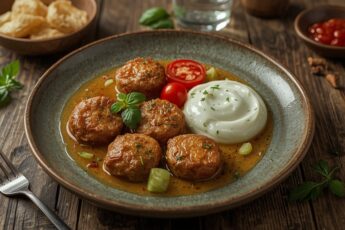The memory of the first Sunday roast I perfected is still as vivid as if it happened yesterday. It was a typically frosty winter day, the type that chills your bones even within the warmth of your home. My beloved grandmother had recently passed away, leaving behind her precious trove of recipes. Among her age-worn index cards, I discovered it, simply named, “My Roast”. With a sense of purpose, I resolved to pay tribute to her legacy and set off on my gastronomic journey. The moment you place the roast in the oven, a unique joy emerges from the ensuing spectacle. The enticing hiss as the meat encounters the high temperature, the tantalizing scent of the savory ingredients permeating throughout the kitchen. Every ingredient plays a critical role; the rosemary unleashes its aroma, garlic mellows into a sweet surrender, and the roast’s skin crisps beautifully. It’s truly a sensory experience before you have even tasted a bite. This recipe is much more than a delightful gustatory adventure; it’s a salute to enduring customs and a symbol of familial bonds. The Sunday roast was a much-anticipated event in our family, an opportunity to congregate around the table, exchanging laughter, affection, and animated discussions. My grandmother’s roast was the bonding element that brought us together. Now, I continue the tradition, utilizing the same recipe, providing solace on days when life seems a tad overwhelming. However, as with every homemade dish, it never quite mirrors the original. My roast occasionally presents a slightly burnt edge, and the kitchen inevitably looks like a war zone afterward. Yet, therein lies the charm. The appeal of homemade is in its flaws, each revealing a bit of the love and effort invested. The Sunday roast is a symbol of British gastronomy, reflecting the nation’s rich culinary history. The dish’s origins go back to medieval times when serfs would present their lords with a substantial roast post-church on Sundays. Today, it continues to bring comfort to countless homes worldwide, a tribute to enduring flavors and traditions. As you explore this recipe, you’re reigniting an ancient tradition, and perhaps, initiating a new one. There’s an inexplicable satisfaction in cutting into the roast, steam puffing out, the exterior pleasingly crunchy with the interior remaining juicy. It’s a dish that nourishes the spirit — providing a pleasant interlude in the hustle of life to enjoy something genuinely delectable.
Ingredients
- 1 beef roast weighing around 3.5 kg
- 2 tablespoons of granulated sea salt
- 4 cloves of garlic, finely chopped
- 2 tablespoons of fresh rosemary leaves, minutely chopped
- 1 teaspoon of freshly milled black pepper
- 3 tablespoons of olive oil
- 2 large-sized onions, quartered
- 3 mature carrots, peeled and chunked
- 500ml of beef stock
Instructions
-
Preheat your oven to a temperature of 220 degrees Celsius. This high heat is crucial for achieving a tantalizingly crispy crust on your roast.

-
Massage your beef roast with granulated sea salt, ensuring it’s spread evenly. The salt will not only enhance the meat’s flavor but also help extract its natural juices, leading to a softer roast.

-
Combine the finely chopped garlic, minutely chopped rosemary, and milled black pepper in a small dish. This mixture forms an aromatic rub, infused with fragrant herbs and the pepper’s spicy undertones.

-
Massage the roast with olive oil, then encrust it evenly with your herb rub. This layer of oil will help the rub stick to the roast.

-
Spread the onions and carrots in a durable roasting pan. These vegetables will form a flavorful base for the roast, absorbing its dripping juices while caramelizing in the oven.

-
Place your herb-encrusted roast on top of the vegetable base in the pan. Slide the pan into the preheated oven and let it bake, undisturbed, for 15 minutes.

-
After the initial minutes, reduce the oven temperature to 180 degrees Celsius. Continue to bake for approximately 90 minutes, or until your meat thermometer reads 63 degrees Celsius for medium-rare. This slow baking process ensures the roast remains juicy and tender.

-
Once the roast is cooked to your liking, remove it from the oven and let it rest for a minimum of 20 minutes. This resting phase allows the juices to evenly distribute throughout the roast, ensuring each slice is moist and tasteful.

-
As the roast rests, heat the beef stock in a pan, scraping up the caramelized particles at the bottom. Season to taste. This sauce is the finishing touch to your roast, brimming with the roast’s flavors, and ideal for drizzling over the carved meat.

Nutritional Information
- Calories: 560 kcal
- Protein: 46 g
- Fat: 35 g
- Carbs: 10 g
Final Result






